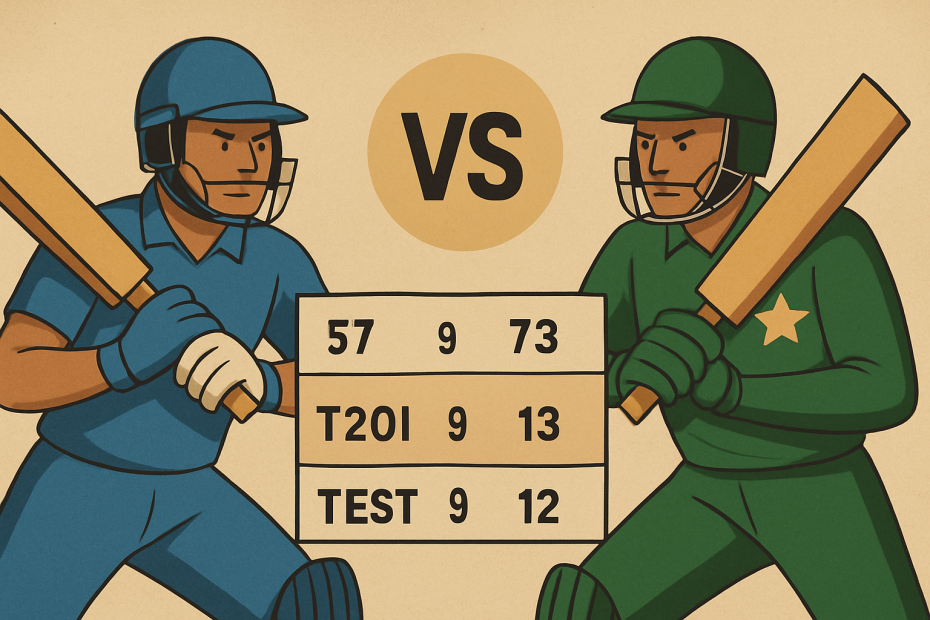Updated on September 13
At a glance: Pakistan lead the rivalry in ODIs and Tests, India lead it in T20Is and dominate ICC tournaments. ODI World Cup head-to-head is eight-nil to India; T20 World Cup tilts seven-one to India.
The India–Pakistan rivalry does not sit quietly in a spreadsheet. It crackles in the air long before the toss, tightens shoulders in warm-ups, and rewrites conventional wisdom under lights. It is tactics built on decades, pressure shaped by generations, and execution under conditions that reduce even masters to novices for a moment or two. Still, the numbers matter. They tell you how often patterns repeat, where edges emerge, and why certain venues or tournaments bend to one flag more than the other. This piece pulls all of that together—format-wise, tournament-wise, venue-wise, and era-wise—while keeping one eye firmly on the cricket that decides everything.
The Big Picture: Head-to-Head Totals
The rivalry has three distinctly different personalities by format: long-form (Tests), one-day (ODIs), and T20 internationals. Pakistan’s early and Sharjah-heavy ODI dominance gives them the historical edge there; India’s modern-limited-overs evolution flips the T20I balance decisively the other way. Tests sit in the middle—scarce in recent times, often attritional when they did happen, and lopsided by draws.
Overall Head-to-Head (men’s senior teams)
| Format | Matches | India wins | Pakistan wins | Draw/Tie | No result |
|---|---|---|---|---|---|
| Tests | 59 | 9 | 12 | 38 | — |
| ODIs | 135 | 57 | 73 | 0 | 5 |
| T20Is | 13 | 10 | 3 | 0 | 0 |
Note: ODI totals include completed internationals and no-results. Test draws are included under Draw/Tie.
What this means:
- Tests: A draw-heavy ledger with Pakistan ahead on wins. The character of these games was defined by conservative match-ups, cautious first innings, and rare fifth-day punches when conditions allowed.
- ODIs: Pakistan hold a historical lead built across long runs at neutral venues—most visibly Sharjah—though India have decisively closed the gap in ICC events and the most recent high-stakes encounters.
- T20Is: India have the clear advantage, reflecting a more consistent white-ball template in big-pressure situations and a bowling group that thrives at both ends of a T20 innings.
ICC Tournaments: The Decider’s Decider
On days when the world is watching as one, India have been ruthlessly consistent. That is the single biggest storyline of the last two decades of this rivalry: tactical clarity meeting composure on the biggest stage.
ODI World Cup
- Head-to-head: India lead eight-nil.
- What the pattern says: Across different venues, generations, captains, and conditions, India have held their nerve better. Even when the surface offers spice up top, Indian new-ball spells have set a tone Pakistan’s top order rarely escaped. When chasing, Indian middle-order clarity has outlasted Pakistan’s mid-innings squeeze. When defending, India have stacked dot-ball pressure like compound interest.
T20 World Cup
- Head-to-head: India lead seven-one.
- Defining memories: The bowl-out classic. The MCG chase that started slowly and finished with audacity. The New York low-scoring masterclass. Different types of pressure, similar outcome: Indian end-overs bowling finds a way; their top order rides the turbulence better than most; their fielding standards typically add ten invisible runs.
Champions Trophy
Head-to-head: Near-even overall, with Pakistan holding a slim edge across editions and a defining win in their last final against India at the event. In group play India have been superior; in one marquee final, Pakistan turned the game decisively in a single hour of batting and a single new-ball burst—one of the most clinical limited-overs performances in the rivalry’s long story.
Asia Cup
ODI and T20I editions combined, India lead the head-to-head across the last several meetings. The modern arc of the Asia Cup reads like a stress test of two systems: India’s batting depth and spin control tend to carry the day when conditions slow; Pakistan’s high-quality left-arm pace and late-order power threaten to turn those days on their head when the new ball talks or when a set batter carries through.
ICC-only Record (World Cups + Champions Trophy) — Snapshot
| Tournament | India wins | Pakistan wins | Snapshot |
|---|---|---|---|
| ODI World Cup | 8 | 0 | India unbeaten in this fixture across all editions |
| T20 World Cup | 7 | 1 | India dominate the match-up in varied conditions |
| Champions Trophy | 2 | 3 | Group-stage wins to India; final-day glory to Pakistan |
| ICC global (combined) | 17 | 4 | India own the big stage overall |
Venue and Country Splits: Where Conditions Speak
This rivalry doesn’t just change with the ball; it changes with the postcode. The swing of a Gulf evening and the greyness of an English afternoon create entirely different problems. Captains know it. Coaches plan for it. The patterns hold across decades.
- Neutral venues (ODIs): Historically tilted toward Pakistan, anchored by a long run of Sharjah tri-series where they rode reverse swing, fielding traps on big boundaries, and unfussy middle-order partnerships. That era built a cushion that still shows in the overall ODI tally.
- Neutral venues (ICC events): India’s ground. Global tournaments are where India’s skill-depth shows up. Selectors have repeatedly brought tournament-specific balance—two new-ball seamers with defensive skills at the death, a wrist-spinner or mystery option for the middle overs, and a bench that can cover two roles if needed. This isn’t a quirk; it’s design.
- In India: Bigger grounds, truer pitches, and noisy evenings. India’s limited-overs advantage at home has widened over time, particularly when spin finds grip and when their top order bosses the first powerplay. Pakistan’s best chances on Indian soil have historically come with new-ball bite or when they’ve forced India into early middle-overs rebuilds.
- In Pakistan: White-ball cricket here has generally rewarded Pakistan’s seamers more regularly, especially with a touch of movement under lights. Their ODI edge at home is part nostalgia, part muscle memory, and part conditions that put the Indian top order under first-spell examination.
- UAE (Sharjah, Dubai, Abu Dhabi): Two different rivalries in one geography. Sharjah carries the weight of Pakistan’s ODI dominance across a long stretch. Dubai and Abu Dhabi have modernized the storyline: bounce a fraction truer, outfields quicker, and the T20I balance more even. Add dew and toss to the equation, and you get razor-thin margins in evening games. In the most recent cycles, each side has posted statement wins here, including a Pakistan ten-wicket dismantling in a T20 World Cup and India’s premium new-ball spells in Asia Cup games.
- England: India’s zone in ICC clashes. Control with the new ball, batting patience when the ball seams, and an outfield that rewards running between the wickets. Pakistan’s ceiling in England is high—when their seamers hit the cordon they look unbeatable—but India have repeatedly played the long game better.
- Sri Lanka: India have typically handled run-rates and surfaces better in multi-team tournaments here. Climatic conditions mean the toss matters; India’s toss-loss recovery plans have been excellent in recent meetings.
- Australia: The MCG epic told you everything about pressure management during a chase on a big Australian ground. India’s end-overs hitting and running have tilted contests; Pakistan’s pace still bites, especially under lights.
- North America: A single, low-scoring T20 World Cup meeting at New York delivered drama of a different kind—adaptation to a tricky surface, premium new-ball spells, intelligent target recalibration, and late-innings nerve. India survived, barely, and with that protected a near-perfect T20 World Cup record in the rivalry.
Venue Tilt Snapshot
| Split | Tilt | Context |
|---|---|---|
| Neutral venues, ODIs | Pakistan advantage | Sharjah era built a long-term cushion |
| Neutral venues, ICC | India advantage | Tournament-specific planning and execution |
| In India | India advantage (LOI) | Spin control and top-order tempo |
| In Pakistan | Pakistan advantage (ODI) | First-spell movement and white-ball angles |
| UAE overall | Closer in T20Is; historic ODI tilt to Pakistan | Conditions and dew create toss-weighted games |
| England (ICC) | India advantage | Powerplay survival and end-overs clarity |
| Sri Lanka (multis) | India advantage | Middle-overs control with spin and tempo shifts |
| Australia (ICC) | India advantage | End-overs batting and larger-ground defense |
| New York (T20 WC) | India advantage | Single, low-scoring thriller showcased adaptation |
The Rivalry by Format: How Games Are Won
Tests: Patience and control
- The draw column is the headline. Surfaces across the subcontinent during marquee tours often ran slow after first innings and demanded double-centuries worth of occupation rather than bursts of run-rate.
- Pakistan’s edge in wins came from two modes: early reverse swing that shredded India’s second innings when a draw seemed certain, and period-specific batting cores that absorbed pressure for days.
- India’s wins tended to arrive when their spinners got bite on the fifth afternoon or when a fast bowler caught a second wind with the old ball. The decisive passage in Tests between these teams is rarely the new ball; it’s the first spell after tea on day four and the first hour of day five.
ODIs: Balance, power, and the first ten overs
- Pakistan’s historical ODI lead is the story of relentless seam options and sharp catching inside the circle at neutral venues. During that span, India often batted into the pitch, then watched as Pakistan’s middle-overs seam pair turned the screw and a gold-standard finisher closed games in silence rather than fireworks.
- The modern phase has reversed many of those trends. India’s white-ball engine is built on two powerplays. With the bat, they go harder at the top than in older eras and are comfortable burning a few overs to reduce risk if a pitch plays trickier than it looked. With the ball, their best ODI wins in recent years are built on full-lengths in the first five overs, a wrist-spinner’s middle-overs control, and a wicket-taking second spell from a lead quick.
- Chasing vs defending matters. In cooler evenings with a touch of dew, both teams prefer to chase unless an elite bowling day makes 280 feel like 320. In continental humidity and slower pitches, a bat-first decision with a 300-plus target anchored by a set top-order batter has historically felt decisive.
T20Is: Powerplay clarity vs end-overs nerve
- India’s T20I dominance is built on two things: clarity in the first six overs—in terms of role and risk—and nerve in the last four. Their most defining victories have featured a calm acceleration rather than a crash; a last-over blockhole plan with contingency; and fielders who turn potential twos into suicidal singles.
- Pakistan’s path to T20I wins has been equally clear when it has come: a burst from a left-arm quick that removes a kingpin early; a middle-overs spell that turns ones into dots; and two set batters carrying the chase into the late teens. When they get that sequence, the result has often been emphatic.
Record-Type Highlights: What Still Stops You in Your Tracks
- Biggest ODI win by runs in the rivalry: India’s record-breaking margin at Colombo, where a top-order clinic and a wrist-spinner’s five-for turned a marquee night into a romp.
- The biggest T20I win by wickets between the sides: Pakistan’s ten-wicket canter in Dubai—chase recalibrated to perfection, openers unbroken, and India’s attack unable to find the change-up.
- Highest ODI chase in this rivalry: India’s Karachi classic, overhauling a total in the mid-340s with ice-cold late hitting and earlier acceleration that looked aggressive for its time.
- Highest individual ODI score vs India: Saeed Anwar’s 194 at Chepauk, an innings that glowed with timing and tempo long before T20 hitting rewrote the script.
- Iconic finishing stand in a T20I: The MCG epic—pressure reduced to moments, angles to arcs, and a death-over blueprint executed with nerveless precision.
Player vs Team: Mini Dashboards
Virat Kohli vs Pakistan
The definition of “big-match” for India in the last decade. Out-and-out T20I impact, yes, but also crucial ODI stands that broke the back of the chase. Key trait: rides the early swing with an economy of risk, then expands almost invisibly into the late overs. Against Pakistan’s left-arm angle, his back-foot late cut and front-foot check drive have been priceless.
Rohit Sharma vs Pakistan
When he clears the front leg early, India’s day looks different. One of the biggest ODI wins in the rivalry was built on Rohit’s high-order tempo and a square-of-the-wicket scatter that ignored early swing. His captaincy in limited overs has also tilted India towards proactive fields in the powerplay and flexible fifth-bowler usage.
Sachin Tendulkar vs Pakistan
The aura, the uppercut, the needle of a rivalry within a rivalry. Tendulkar’s ODI volume against Pakistan stands among the highest by any batter against any opponent, but the more telling note is his ability to rewrite passages under severe early pressure. Attacking Saeed Anwar’s record day was rare; surviving Wasim and Waqar spells with run-rate intact rarer still.
Jasprit Bumrah vs Pakistan
If a moment has to be defended in the last two overs, this is the bowler you’d pick. Back-of-a-length that sits up and then climbs, yorkers picked out of thin air, and slower balls that die on the pitch. Against Pakistan’s finishers, Bumrah has often erased the angle of their swing entirely.
Kuldeep Yadav vs Pakistan
A left-arm wrist-spinner with control is a white-ball luxury. Around the wicket, attacking the stumps, beating batters both ways—Kuldeep has banked match-shaping spells against Pakistan, especially when India built a cushion with the bat and defended with a plan: spin to squeeze, pace to kill.
Babar Azam vs India
Class and range off the back foot. When Babar wins his match-up early, Pakistan’s innings becomes organized in a way that shows in the last five overs. Against India’s new-ball pair, survival in the first three is the hinge; from there, his cover-drive lanes open and strike-rotation resets the innings.
Mohammad Rizwan vs India
The busiest pair of feet in a Pakistan shirt for T20 chases. Rizwan’s running, strike manipulation, and hit-down-the-ground options in powerplay overs have framed some of Pakistan’s biggest T20 statements. When he carries deep, Pakistan win rates jump.
Shaheen Afridi vs India
The delivery that bends back from just outside off is the thread connecting many of Pakistan’s best new-ball moments against India in the modern era. Against right-hand giants, Shaheen’s first two overs decide the kind of day Pakistan will have.
Mohammad Amir vs India
A big-game swing bowler with a head for theater. When Amir’s wrist is behind the seam and the ball swings at chest height, India’s elite top order has occasionally looked mortal. Pakistan’s most complete white-ball win in the rivalry featured an Amir spell that ripped the heart out of India’s chase before it started.
Wasim Akram and Waqar Younis vs India
The bible of reverse swing. Their legacy in this rivalry is not just wickets; it is the dread they implanted mid-innings when a game trending to 260 suddenly pointed to 220. They were the reason many Indian one-day batters of an earlier era learned to score with wrists and soft hands rather than long levers.
Shahid Afridi vs India
Impact by detonation. Afridi owns the rivalry’s six-hitting record in ODIs, and his early-overs leg-spin at times took the top off India’s innings when surfaces gripped. He also defined the Sharjah period with cameos that felt longer than the overs they occupied.
Women’s and Age-Group Rivalries
India Women vs Pakistan Women
- Head-to-head trend: India Women lead in both ODIs and T20Is, built on top-order stability and a spin core that controls the middle overs. The most memorable wins often followed an early stumble—India’s lower middle order has repeatedly bailed them out against Pakistan, with rotation and smart running making the difference.
- Tactical note: Pakistan Women’s seamers shape the ball well in powerplays; India’s answer has been a low-risk first six overs followed by boundary clusters in overs seven to twelve, forcing captaincy changes and breaking field plans.
U19: The future wearing senior nerves
India U19 hold a pronounced edge in knockout-stage meetings at global events. The difference is structure: India’s U19 programs tend to produce a higher number of multi-skill players—batters with a second discipline, bowlers who can bat at seven or eight.
Pakistan U19 sides have delivered extraordinary talents who go on to senior honors; their ceiling, when a generational quick emerges, can be astonishing. But in U19 crunch games, India’s extra batting resource and defensive fielding usually swing the day.
A-Team: Scarce but telling
When these groups have met, the patterns often mirror the seniors. India A bowlers hitting the hard length through the middle overs, Pakistan A top orders trying to ride the early storm. It is quieter cricket with loud consequences: selection committees read these games heavily.
Toss, Batting First vs Chasing, and the Anatomy of a Result
You cannot understand India vs Pakistan without understanding the toss—especially at night—nor can you miss the impact of dew, wind, and boundary size. The best captains in this rivalry have made peace with changing plans on the fly.
Chasing vs defending in ODIs:
- In dry, used surfaces, bat first, bat long, and upgrade the last ten overs with set batters. India’s most dominant wins have followed this script on slow pitches, particularly with wrist-spin waiting at the halfway mark.
- In cool evenings with a hint of dew, both teams prefer to chase unless cross-winds or a patchy pitch changes calculations. Pakistan’s best chasing nights involve a set top-order batter batting deep and a power-hitter at six arriving early.
Chasing vs defending in T20Is:
- India’s template puts a premium on not losing clusters of wickets in the first ten. They improve the pitch with risk control and then cash in. With the ball, they box the powerplay, squeeze the middle even if they go boundary-light, and finish with a yorker/length variation that toggles to batters’ swing.
- Pakistan’s template that breaks India’s usually involves a left-armer creating early wickets and a leg-spinner or mystery option cutting off India’s boundary gear through overs seven to twelve. From there, the chase falls to their anchors—when those anchors go 45 off 35 without damage at the other end, the math flips their way.
Powerplay vs Death:
- Powerplay: India’s new-ball bowlers have improved length control dramatically. Against Pakistan’s right-handers, the plan is simple but hard to execute: top of off, wobble seam, and insist on fourth-stump judgment. Pakistan’s success in this window, meanwhile, is a function of how quickly their top order gets off strike.
- Death overs: Pakistan’s “hit the deck then go full” blueprint has given them stunning returns when backed by fielding that cuts angles to the square boundary. India’s best end-overs resemble a metronome: pace off, yorker, leg-cutter into the pitch, repeat, with fielders pre-empting the swing arc.
Captaincy and Coach-wise Eras
- The Imran–Javed era taught Pakistan to win without asking for applause: par scores defended with hostility and guile, batting that reached its run rate without ever obviously accelerating. Against India, that approach created more wins than any style looking pretty for the cameras.
- India’s Azhar and then early Sachin captaincy periods felt like a learning curve under fire. The technical gulf with the ball was real; the response, for years, was to play around it rather than through it.
- The Ganguly–Wright era gave India steel, a vision of roles, and a willingness to look Pakistan in the eye. Trips to Pakistan and neutral venues during this stretch began to tilt from survival to assertion.
- The Dhoni era delivered limited-overs ruthlessness at ICC events: batting depth without panic, spinners used as wicket-takers not just stoppers, and calm under sunsets that make others jittery.
- The Rohit–Dravid phase has emphasized tempo at the top and tactical flexibility with the ball. Against Pakistan, those choices have translated into the ODI and T20I manner of wins you recognize instantly: first ten overs won, last ten overs controlled.
Streaks and Inflection Points
- India’s ODI World Cup streak: a psychological edge that now lives rent-free in selection meetings. This streak is not a talisman; it is the product of seamers hitting that uncomfortable length with new balls and batters who treat key spells with respect rather than pride.
- Pakistan’s Sharjah decades: the place where they learned to chase down 240 like a routine school run and defend 230 with a map of the square boundary in their heads. That memory, and the habits it created, still shows up in their approach in the Gulf.
- T20 World Cup resilience: India’s ability to withstand early collapse and still make a chase happen is a signature trait. Pakistan’s response in their best T20 wins—skip the rebuild, double down with a set pair—remains the antidote.
By the Numbers: Rivalry Highlights You Can Recite
- ODI World Cup head-to-head: India lead eight-nil.
- T20 World Cup head-to-head: India lead seven-one.
- Champions Trophy overall: Pakistan edge the ledger across editions, including a final-day statement win.
- Highest ODI chase in the rivalry: India, Karachi, mid-340s.
- Biggest ODI win by runs: India, a 200-plus statement at Colombo.
- Most sixes vs India in ODIs: Shahid Afridi, the long-handle personified.
- Rivalry’s standout ODI bowling analysis: Aaqib Javed’s seven-for at Sharjah, a masterclass in white-ball seam.
Strategy Lab: How Each Side Wins the Next One
If you strip away the anthem, the armbands, and the crackle, you’re left with a match-up shaped by repeatable ideas.
India’s winning blueprint
- With bat: focus on one of two routes—either safe progress to the halfway mark with wickets in hand, then a par-scorching final ten; or a fast start with calculated risk against the hard ball, handing the middle overs to your best rotators. Against Pakistan’s left-arm spearhead, protect your stumps early; your game starts at over seven, not over one.
- With ball: three spells decide the day—overs one to five with seam on a fullish length to the right-hand line; overs eleven to nineteen where wrist spin or off-speed seam denies easy singles; overs forty-one to forty-nine where the bowling unit toggles speed and length by batter swing arc rather than by over.
Pakistan’s winning blueprint
- With bat: you need one anchor and one hitter to be in at over fifteen. Start like a test match for three overs if needed; once set, trust lanes—Rizwan straight, Babar square, a left-hander targeting leg-side pockets, and late-order muscle targeting midwicket. Against India’s wrist spin, the cut becomes your friend as much as the slog-sweep.
- With ball: the first powerplay must leave India two down with a sub-run-a-ball rate. A left-armer angling in from over the wicket to the right-hander is your old friend—use it. Back it up with a leg-spinner or a cutter specialist who turns dot-balls into scoreboard pressure. And, critically, don’t bleed twos on the big side; concede the single to keep the field set.
Neutral-Venue Dynamics You Can Bank On
- Dew is not an excuse; it is a plan. Both teams now practice with wet balls before night games at Gulf venues. The difference shows in finger positions and pace-off execution under lights.
- Boundary geometry changes shot selection. In Dubai and Abu Dhabi, the square boundary can be the larger side; the best chasers aim ground strikes there and aim big hits straight.
- Wind matters. Bowlers who know when to use the cross-wind as a second field bring an invisible edge that becomes very visible at the death.
Coaching and Selection Levers That Shift Matches
- India’s bench often includes a batter who can bowl a few overs and a bowler who can bat at eight. Against Pakistan, that has insulated them against collapses and allowed aggressive fields for longer.
- Pakistan’s best squads against India have featured two left-arm options who do different things—one hits the length at pace, the other hunts for swing and yorkers; then, an attacking leg-spinner with the confidence to bowl at set batters.
- Wicketkeeping is not a footnote. A missed chance early against these batting line-ups often costs sixty, not sixteen. The most recent India wins in ICC games include at least one tough take that broke a partnership early or saved a death-over boundary.
Women’s, U19, and A-team: Why These Matter to the Senior Rivalry
- These games engrain habits. India Women’s tendency to control the middle overs with spin and win the last three overs with running has a direct senior parallel. Pakistan Women’s best days—new-ball incisiveness and sharp in-fielding—mirror the men’s.
- At U19 level, India’s deeper pool of role players shows in selection for finals; Pakistan’s pipeline of pace continues to be the envy of everyone. When the seniors meet, you see these histories play out in micro-choices under pressure.
Rivalry FAQ: The Quick Answers
- More overall wins across formats: Pakistan, thanks to a historical ODI edge and a small lead in Tests. India lead in T20Is.
- India vs Pakistan World Cup head-to-head: India are unbeaten in ODI World Cup meetings with an eight-zero record.
- Times India have beaten Pakistan in ODI World Cups: eight.
- Last Pakistan win against India in a World Cup: the T20 World Cup in the Gulf, a ten-wicket win that remains their standout in the format against India.
- India vs Pakistan T20 World Cup record: India lead seven-one.
- Most memorable modern ODI wins for India: the Colombo statement and the Ahmedabad surge; one built on a massive margin, the other on bowling precision under lights.
What To Watch Next: A Rivalry Still Evolving
The most recent chapters say as much about preparation as they do about pressure. India’s back-room planning has found line-and-length answers to Pakistan’s best powerplay questions. Pakistan’s reply—when it bites—arrives in the purest form of fast bowling theater: a left-arm ball that swings late and makes the best in the world feel mortal for half an hour. Add T20 pitch variability in new markets, more ICC events on neutral soil, and a generation of batters unafraid to go aerial in over four, and you have a rivalry that has upgraded without losing its essence.
If you reduce it to a single line, it is this: India control ICC days; Pakistan still own large chunks of the rivalry’s ODI memory; T20Is tilt India’s way because of repeatable endgame skills. In between the numbers is everything that keeps us coming back—the sound of a new ball kissing the seam, a shot held a fraction longer through cover, a quieter over from a wrist-spinner that shifts a chase by ten runs, and a fielder who takes the angle that no one else saw.
Appendix: Quick-Glance Tables
Overall head-to-head (men’s)
| Format | Matches | India wins | Pakistan wins | Draw/Tie | No result |
|---|---|---|---|---|---|
| Tests | 59 | 9 | 12 | 38 | — |
| ODIs | 135 | 57 | 73 | 0 | 5 |
| T20Is | 13 | 10 | 3 | 0 | 0 |
ICC tournaments (men’s)
| Tournament | India wins | Pakistan wins | Snapshot |
|---|---|---|---|
| ODI World Cup | 8 | 0 | India unbeaten in this fixture |
| T20 World Cup | 7 | 1 | India’s death-overs blueprint holds |
| Champions Trophy | 2 | 3 | Group-stage India; final-day Pakistan |
| ICC global (combined) | 17 | 4 | India dominate the big stage |
Venue tilt
| Split | Tilt | Context |
|---|---|---|
| Neutral venues, ODIs | Pakistan advantage | Sharjah legacy |
| Neutral venues, ICC | India advantage | Preparation + balance |
| In India | India advantage (LOI) | Spin and top-order tempo |
| In Pakistan | Pakistan advantage (ODI) | New-ball movement |
| UAE (overall) | Closer in T20Is | Dew and toss heavy |
| England (ICC) | India advantage | Powerplay survival |
| Sri Lanka (multis) | India advantage | Middle-overs control |
| Australia (ICC) | India advantage | Larger-ground defense |
| New York (T20 WC) | India advantage | One-off low-scorer |
Closing Thought
These contests are living things. Scorecards age, but the shapes of these games—how India build a chase with patience and a burst, how Pakistan turn a game in ten balls with left-arm shape—continue to repeat in ways that feel familiar and brand new at the same time. The record books speak clearly: Pakistan guard their ODI history fiercely; India hold the ICC tournaments with both hands and don’t let go; T20Is reward India’s sangfroid. Yet nothing is guaranteed. That’s the secret pulse of India vs Pakistan. You think you know where it’s going, and then one ball skips, one field is changed, one plan is adjusted, and everything changes. That’s why the numbers matter—and why the cricket matters more.
Related posts:
Psl winners list: Season‑by‑season champions & finals
About vignesh puthur - Official bio, work & contact
How Many Countries Play Cricket? 108 ICC Members (Updated Oct)
Complete mlc t20 Guide: Schedule, Scores, Teams & Tickets
CSK owner: Chennai Super Kings Ownership Explained
Fantasy App List: Expert Picks for Cricket, NFL, NBA & More
Angad Mehra

- Angad Mehra is an avid cricket analyst and sports writer who pays attention to betting patterns and match specifics. Angad has years of experience writing, covering both Indian and international cricket. He explains stats, odds, and strategies in a clear, simple manner that resonates with fans. Readers trust Angad’s articles to keep them ahead of the game whether on or off the field. Off the field, you can find him either tracking live scores ball by ball or debating IPL lineup changes.
Latest entries
 GeneralOctober 27, 2025Psl winners list: Season‑by‑season champions & finals
GeneralOctober 27, 2025Psl winners list: Season‑by‑season champions & finals GeneralOctober 25, 2025About vignesh puthur – Official bio, work & contact
GeneralOctober 25, 2025About vignesh puthur – Official bio, work & contact GeneralOctober 23, 2025How Many Countries Play Cricket? 108 ICC Members (Updated Oct)
GeneralOctober 23, 2025How Many Countries Play Cricket? 108 ICC Members (Updated Oct) GeneralOctober 21, 2025Complete mlc t20 Guide: Schedule, Scores, Teams & Tickets
GeneralOctober 21, 2025Complete mlc t20 Guide: Schedule, Scores, Teams & Tickets
